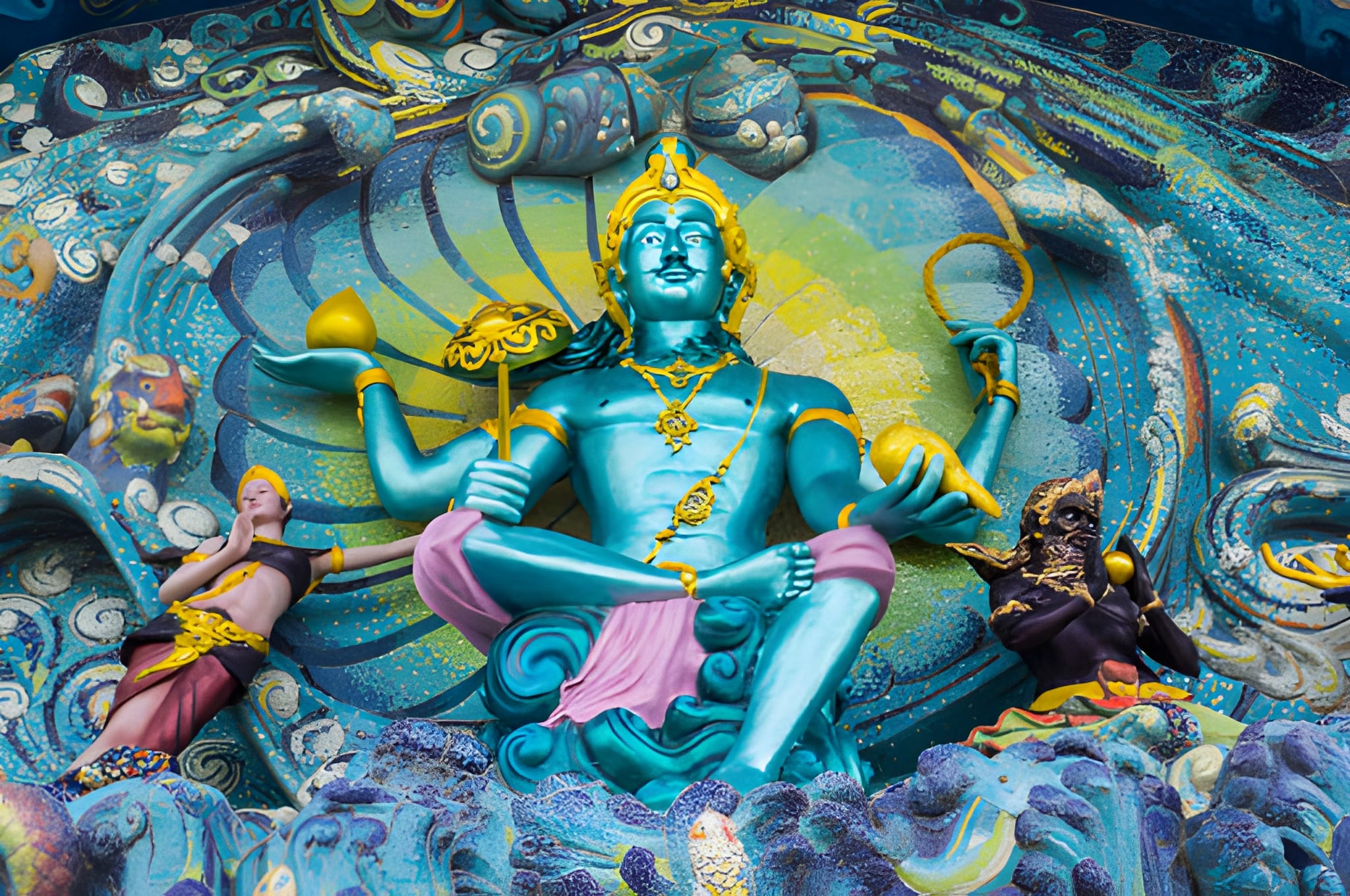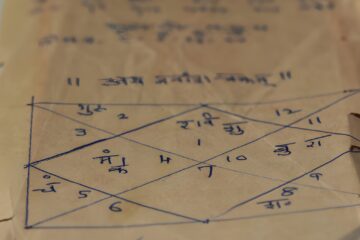Sadhe Sati in Vedic astrology is a long, slow negotiation between your emotional body and reality. It is not a curse. It is not automatic tragedy, but it’s Saturn moving across the most sensitive point in your chart — the Moon — and asking one direct question: can your inner world handle what your outer world has already created?
The phrase “Sadhe Sati” literally means “seven and a half.” It refers to the roughly 7.5-year period in which Saturn transits the sign before your Moon, the sign of your Moon itself, and the sign after it. Saturn spends about two and a half years in each sign, so this full arc becomes a sustained cycle of compression, refinement, and emotional audit.
To understand the effects of Sadhe Sati, you have to see Saturn for what it is. Saturn is consequence. Saturn is structure. It is time. When time finally reaches the mind and says “enough performance,” people call it suffering. When time reaches the mind and says “you are ready to be taken seriously,” people call it maturity. Both are Sadhe Sati.
What Exactly Is Saadhe Sati?
Traditional definition: Saadhe Sati begins when Saturn enters the sign immediately before the natal Moon sign, continues as Saturn moves over the natal Moon sign itself, and ends when Saturn finishes transiting the sign after the natal Moon. This is why people say it lasts about seven and a half years.
Technical definition: some astrologers define it even more precisely — Saturn moving through approximately 45 degrees before and 45 degrees after the Moon’s exact longitude in your birth chart. Either way, the logic is the same. The Moon is your psychological climate. Saturn is pressure, obligation, accountability. Sadhe Sati is when pressure sits on the mind long enough that superficial coping strategies stop working.
There is also a related transit called Dhaiya (or “Dhaiyya”): a shorter, approximately 2.5-year period when Saturn moves through the 4th or 8th house from the natal Moon. Dhaiya is like a focused rehearsal of Sadhe Sati — serious, but narrower in scope.
In modern language: Sade Sati is Saturn’s extended Saturn transit over Moon influence. Dhaiya is Saturn leaning hard on one emotional axis for a shorter window.
Why People Fear Sade Sati
People are taught to fear Sadhe Sati because they are taught to fear Saturn. Saturn is described as a punisher — disease, loss, humiliation, breakups, career collapse, isolation. The story goes: “When Sade Sati comes, everything goes wrong.”
This is not clean astrology. This is superstition mixed with trauma.
Saturn does not steal what is truly yours. Saturn removes what is unsustainable. If you’ve built your self-worth on attention instead of integrity, Saturn will remove the attention. If you’ve built your marriage on performance instead of truth, Saturn will press until someone admits the truth. And, if you’ve built your career on image instead of competence, Saturn will test competence.
This is why Sadhe Sati in Vedic astrology is often remembered not as “bad,” but as “the time I had to grow up,” “the time I finally stabilized,” “the time I stopped pretending.” For people who are already disciplined, ethical, and consistent, Sadhe Sati can bring consolidation and recognition instead of visible suffering.
The Reality of Saadhe Sati
Here is the real core: Saturn is slow, impartial, and transactional. It is not emotional. It does not care if you feel ready, but only cares if the structure you are living in is honest and durable.
That’s why two people in Sade Sati do not live the same story. The effects of Sadhe Sati in Vedic Astrology depend on:
- Saturn’s dignity in the natal chart (own sign, exalted, debilitated, friendly, etc.).
- Which houses Saturn rules for your Moon sign and for your Ascendant. Functional benefic or functional malefic matters more than generic “good/bad planet.”
- How Saturn aspects or conjoins the Moon. A clean supportive aspect is very different from a suffocating conjunction under malefic influence.
- Ashtakavarga strength — both BAV (planet-specific bindus) and SAV (total support in the sign).
- The active Dasha. If you are already running Saturn Mahadasha or Antardasha, Sadhe Sati intensifies. If you are in a benefic Dasha with strong Jupiter or Venus support, the same transit becomes survivable, even elevating.
One more nuance: in charts where Saturn is already a yoga karaka (a structured benefic, especially for Taurus, Libra, Capricorn, Aquarius types), the so-called “trouble” of Saadhe Sati often becomes a period of serious rise. You’re still tired. You’re still under test. But the test is, “Can you hold what you’ve built?” not “Will you lose everything?”
General Observations and Principles
Below are working guidelines for Sadhe Sati in Vedic astrology. These are patterns, not verdicts. Use them to think, not to panic.
1. Favorable Moon signs.
For Taurus, Libra, Capricorn, and Aquarius Moons, Saturn tends to behave like a functional benefic or even a yoga karaka. Sade Sati here can feel like sober expansion: responsibility increases, but so does credibility. You are taken seriously. You become structurally relevant.
2. Neutral / mixed Moon signs.
Gemini and Virgo Moons often experience a disciplined, practical tone. Saturn and Mercury can work together. The period may feel busy, strategic, logistical. There is pressure, yes, but also intelligent problem-solving.
3. Challenging Moon signs.
Cancer and Leo Moons tend to feel emotional or egoic stress because Saturn is naturally uncomfortable with the rulers of those signs (Moon and Sun). Expect tests around security, pride, identity, parent-figures, visibility. This isn’t punishment. It’s recalibration of attachment and self-image.
4. Saturn Dasha overlap.
If Sadhe Sati happens during Saturn Mahadasha or Antardasha, the experience intensifies. This is full contact with Saturn’s curriculum. Everything Saturn represents in your chart becomes non-optional.
5. Functional nature matters more than rumor.
Always ask: is Saturn a benefic or malefic for this chart? If Saturn is functionally benefic from both Lagna and Moon, Sadhe Sati tends to mature you, not destroy you. If Saturn is a functional malefic, unmanaged stress is higher.
6. House activation.
During Sade Sati, the houses Saturn rules from the Moon sign “light up.” For Taurus Moon, Saturn rules the 9th and 10th. So dharma, authority, career, father/mentor themes, respect, and professional standing all get audited.
7. Natal placement of Saturn.
Saturn placed in the 3rd, 6th, or 11th houses in the birth chart usually handles Sadhe Sati constructively. These are effort, service, and gain houses. Saturn in 1st, 4th, 8th, or 12th is more emotionally intense: identity strain, domestic strain, psychological upheaval, isolation.
8. Ashtakavarga strength.
If Saturn transits a sign with strong BAV (4+ bindus for Saturn) and high SAV (above ~30), the transit’s harsh edge softens. Numbers matter. High Ashtakavarga scores can “cushion” what would otherwise be rough.
9. Planetary company.
Sadhe Sati is lighter when Saturn is supported by benefics like Jupiter or Venus in transit or aspect. It is heavier when Saturn travels with Mars, Rahu, or Ketu. Saturn+Rahu can feel like political stress, psychological compression, paranoia. Saturn+Mars can feel like exhaustion and confrontation.
10. Retrograde windows.
When Saturn turns retrograde during Sade Sati, pressure can shift from “external events attacking you” to “internal review mode.” You still feel the weight, but the focus becomes reflection and correction instead of public crisis. Retrograde does not erase the transit, but it can slow the blow and let you reorganize yourself.
11. Jupiter’s aspect.
A clean Jupiter aspect to Saturn during Sadhe Sati is one of the softest protections available. Jupiter adds meaning, hope, guidance. Without Jupiter, Saturn feels like isolation. With Jupiter, Saturn feels like discipline-with-purpose.
12. Nakshatra and Moon strength.
If the Moon is strong (bright, supported, dignified) in the natal chart, emotional stability in Sadhe Sati improves. If the Moon is already weak, afflicted, or anxious, this is when you learn emotional endurance. The Moon’s nakshatra and Saturn’s transit through that nakshatra add detail to timing, intensity, and theme.
Lessons of Saadhe Sati
The lesson of Saadhe Sati is not “suffer.” The lesson is “mature.”
Saturn’s voice in this cycle says:
- Show me your reality, not your costume.
- Stop outsourcing self-respect to approval.
- Take responsibility for the structures you live inside: work, money, relationships, body.
- Become reliable to yourself.
If you resist this, Sade Sati feels like oppression. If you align with it, Sadhe Sati feels like final preparation — the part of the movie where the protagonist stops being talented and becomes disciplined.
In that sense, Saturn Sade Sati meaning is simple: Saturn is not here to break you. Saturn is here to make sure you are actually built.
Important Notes
Is Sadhe Sati calculated from the Moon sign or the Ascendant?
Classically, Sadhe Sati is calculated from the Moon sign, not the Ascendant. The Moon is the field of emotion, fear, instinct, memory, nervous system. That’s what Saturn leans on. However, you should still study Saturn’s transit from the Ascendant for physical and material outcomes. Moon = how you experience it. Lagna = what physically happens.
Is Sadhe Sati easier later in life?
Usually, yes. In your 40s and 50s, you already understand cost, duty, and limitation. You don’t panic when Saturn asks for responsibility — you expect it. Younger natives feel it as “Why me?” Older natives often feel it as “It’s time.” Saturn rewards maturity.
Does Sadhe Sati get longer because Saturn goes retrograde?
The total window is still around seven and a half years. Retrograde can stretch certain chapters by a few months, but the scale does not explode to ten years. What retrograde really changes is tone. Instead of pure external pressure, some parts of the transit become internal audit.
Does a retrograde Saturn in the natal chart make Sade Sati kinder?
Not automatically. A retrograde Saturn turns more inward. It can produce self-critique instead of public humiliation, or internal anxiety instead of overt crisis. Whether that becomes growth or paralysis depends on Saturn’s dignity and rulership in your chart.
If Saturn is exalted and Moon is in Capricorn, will Sadhe Sati be beneficial?
Often yes. For a Capricorn Moon, Saturn is lord of the Moon sign itself and tends to function as a benefic. An exalted Saturn can turn Sadhe Sati into consolidation, career authority, structural respect. It may still feel demanding — nothing about Saturn is “effortless” — but the arc bends toward stability instead of collapse, especially with good Ashtakavarga numbers.
FAQ on Sadhe Sati in Vedic Astrology
Can the depositor of the Saturn transit change the outcome of Sadhe Sati?
Yes. The strength and dignity of the lords of the 12th, 1st, and 2nd houses from the Moon act like translators. Strong, well-placed depositors can channel Saturn’s pressure into growth, responsibility, and elevation instead of burnout. Weak depositors can make the same transit feel harsher and more chaotic.
Is Sadhe Sati felt if Saturn is transiting the Ascendant instead of the Moon?
Technically, Sadhe Sati is defined only by Saturn’s relationship to the Moon. But Saturn transiting the Ascendant absolutely matters: it hits health, stamina, public identity, physical environment. For full analysis you read both — Moon-based Sadhe Sati for emotional climate, Lagna-based transit for lived circumstance.
What is the significance of “Paya” (metal cycle) during Sadhe Sati?
Traditional systems classify parts of Sadhe Sati as gold, silver, copper, or iron “feet,” each color suggesting relative ease or challenge. Paya can be suggestive, but it is secondary. Saturn’s functional nature, rulerships, dignity, and Ashtakavarga support carry far more predictive weight than Paya alone.
Is Blue Sapphire (Neelam) always helpful during Saadhe Sati?
No. “Remedies for Sade Sati” are not one-size-fits-all. Blue Sapphire amplifies Saturn. If Saturn is benefic and well-placed for your chart (Capricorn, Aquarius types, or charts where Saturn is yogakaraka), it can stabilize you. If Saturn is hostile in your chart, Sapphire can intensify pressure. You test it carefully, under supervision, before committing.
Does Saadhe Sati always bring hardship?
No. For many, Saadhe Sati is the era of actual growth: career crystallizes, identity matures, relationships become honest, illusions fall away. Saturn does not instantly reward. Saturn rewards what is real and sustained. Saadhe Sati is not a death sentence. It is a mirror — and most people are more afraid of the mirror than of Saturn itself.
Ask your karma. Decode your chart at Much Needed Astro.



